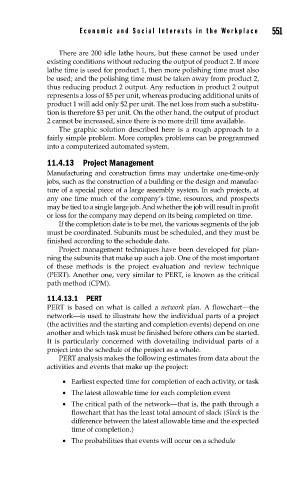Page 598 - Sensors and Control Systems in Manufacturing
P. 598
Economic and Social Inter ests in the Workplace
There are 200 idle lathe hours, but these cannot be used under 551
existing conditions without reducing the output of product 2. If more
lathe time is used for product 1, then more polishing time must also
be used; and the polishing time must be taken away from product 2,
thus reducing product 2 output. Any reduction in product 2 output
represents a loss of $5 per unit, whereas producing additional units of
product 1 will add only $2 per unit. The net loss from such a substitu-
tion is therefore $3 per unit. On the other hand, the output of product
2 cannot be increased, since there is no more drill time available.
The graphic solution described here is a rough approach to a
fairly simple problem. More complex problems can be programmed
into a computerized automated system.
11.4.13 Project Management
Manufacturing and construction firms may undertake one-time-only
jobs, such as the construction of a building or the design and manufac-
ture of a special piece of a large assembly system. In such projects, at
any one time much of the company’s time, resources, and prospects
may be tied to a single large job. And whether the job will result in profit
or loss for the company may depend on its being completed on time.
If the completion date is to be met, the various segments of the job
must be coordinated. Subunits must be scheduled, and they must be
finished according to the schedule date.
Project management techniques have been developed for plan-
ning the subunits that make up such a job. One of the most important
of these methods is the project evaluation and review technique
(PERT). Another one, very similar to PERT, is known as the critical
path method (CPM).
11.4.13.1 PERT
PERT is based on what is called a network plan. A flowchart—the
network—is used to illustrate how the individual parts of a project
(the activities and the starting and completion events) depend on one
another and which task must be finished before others can be started.
It is particularly concerned with dovetailing individual parts of a
project into the schedule of the project as a whole.
PERT analysis makes the following estimates from data about the
activities and events that make up the project:
• Earliest expected time for completion of each activity, or task
• The latest allowable time for each completion event
• The critical path of the network—that is, the path through a
flowchart that has the least total amount of slack (Slack is the
difference between the latest allowable time and the expected
time of completion.)
• The probabilities that events will occur on a schedule

